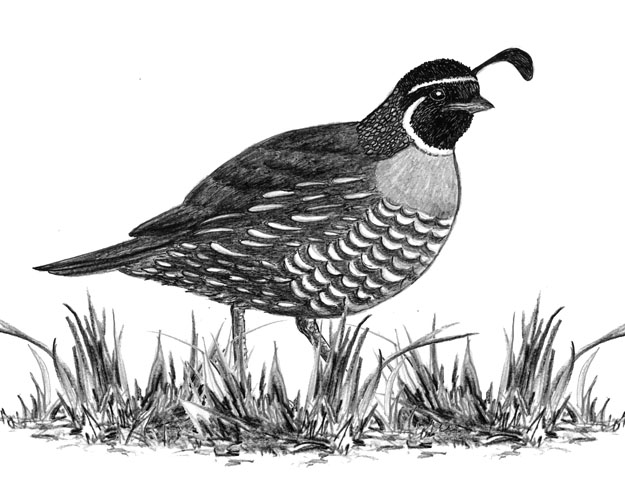
Dear Bird Folks,
I’ve recently moved to Salt Lake City from Rochester, NY and am looking forward to seeing a whole new assortment of birds in my yard. One bird I hope to see is the California Quail. I hear they are common in Utah. My question is: What is the best way to attract quail to my new yard?
– Kenny, Salt Lake City, UT
Lucky you, Kenny,
I have nothing against Rochester, but as far as I’m concerned Salt Lake City has it beat. For one thing, Salt Lake City is surrounded by beautiful snow-capped mountains, while Rochester is surrounded by more New York. Also, downtown Salt Lake City has a famous statue of a gull (or as they call it, a “seagull”). Most cities hate gulls, but Salt Lake City honors them. Gotta love a city like that. In addition to the statue, Salt Lake City has a special bird-friendly law. According to UtahSaltLakeCity.com there is a law stating “birds have the right-of-way on all highways.” How about that? I’m not really sure why they have such a law, but I like it. There’s also a weird non-bird-related law on the books. It states that it’s “illegal for women to swear.” Oh, man. I hope that law is never passed in my area. Cursing at gray squirrels alone would put half of my female customers in jail for ten-to-life.
The California Quail is the quintessential quail. With its weird head plume, it looks like a tiny Shakespearean actor or a member of Robin Hood’s infamous band of Merry Men. (BTW: The distinctive head plume isn’t a single feather, but is made up of six different feathers. Just so you know.) California Quail are handsome, well known birds of the West and the state bird of a very large western state. Any guesses which state that is? I’ll give you a hint. The state begins with the letter “C,” and it’s not Centucky.
Like most quail, California Quail spend much of their lives on the ground, where they scratch for seeds and insects. They are also extremely sociable birds, living most of the year in large flocks. Typically, a flock contains thirty to forty birds, but some super flocks may have several hundred members. Suburban flocks have to deal with manmade obstacles. Just crossing a busy street is a major challenge. This, of course, is not a problem in Salt Lake City, as the birds have the right-of-way. Oh, now I get the reason for the law.
Even though quail are sociable, they can be snobby. Once a flock is formed it becomes difficult for a new bird to join it. Even a flock of 100 members will shun a new bird. Don’t ask me how a covey of 100 identical quail are able to distinguish which birds belong and which are covey wannabes but they somehow know. There must be a password or secret handshake involved. Or, perhaps they have to show their ID…but that probably only applies to birds in Arizona.
When a large flock of these colorful birds invades a backyard it creates quite a chaotic spectacle. There’s always a lot of scratching, picking and eating. But the flock is not as disorganized as it appears. Often a sentry is posted in a nearby tree to watch for signs of possible danger. If trouble is spotted, the guard sounds the alarm call and the birds scatter. Once the danger has passed the birds use a special assembly call to help the flock regroup. But the signature call of the California Quail is a three-syllable call that sounds very much like the bird is saying “Chi-CA-go,” “Chi-CA-go.” The vocalization is repeated several times, sounding like a conductor on a passenger train announcing to travelers that they are arriving in, well…Chicago.
In addition to seeds and insects, these quail also eat an assortment of vegetation, including new shoots, leaves and flowers. Because they don’t have teeth, and thus can’t chew, the birds need help in order to digest this vegetable matter. Researchers have discovered that they have special protozoa in their intestines to assist them with their digestion. But for some strange reason the young quail aren’t born with these protozoans and they must obtain them on their own. And how do they obtain these protozoans you ask? (Get ready.) The young chicks acquire them by eating the droppings of their parents. That’s a bit too gross for me. I didn’t even like walking past the bathroom after my father used it. I couldn’t imagine if I had to…never mind.
For the most part, California Quail have adapted well to humans. They know there are always good things to eat underneath our bird feeders. You should note that yards with thickets, brush and natural cover are more appealing to them than yards with stupid lawns and prissy landscaping. If I were you, I would sprinkle some corn, millet or traditional mixed “birdseed” around some of the natural parts of your yard and hope for the best. You should also put out a ground-level birdbath and make sure that your area is protected from those dreaded uncontrolled cats. If you see a cat in your yard, Kenny, you have my permission to yell at it and call it every name in the book. Just don’t let your wife join in. One slip of the tongue and she could end up doing time in Utah’s swearing prison, the notorious Profanity Penitentiary. That place is bad, especially the warden. I hear he’s a real #@$#&!!!*!